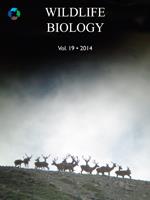Thermal cover may influence habitat selection by white-tailed deer Odocoileus virginianus in subtropical climates with hot summers. We 1) tested the hypothesis that thermal environment is more important in habitat selection at midday during summer than forage quality or quantity and concealment cover and 2) determined whether operative temperature, vegetation height, or woody plant canopy cover (or some combination of these) explain habitat selection at midday. We predicted that during crepuscular periods and at night habitat use increases with increasing forage quality and quantity and concealment cover and is unrelated to thermal environment. Male white-tailed deer were fitted with GPS collars to determine resources selected within habitats during June and July 2008 and 2009. A generalized linear mixed model using logistic regression was used to estimate resource selection functions. We used the first principal component in a principal components analysis (PCA) of forage standing crop, crude protein, and acid detergent fiber (ADF) to create a ‘forage index’. This index and vegetation height, operative temperature and concealment cover, together with their interactions with activity period, were used to develop a priori candidate models. Akaike weights were used to compare candidate models. A model that included the forage index, vegetation height, operative temperature, concealment cover and their interactions with activity period was the best model out of 97 candidate models for explaining habitat selection by adult male white-tailed deer. Male white-tailed deer selected areas with taller vegetation in morning and midday activity periods but selected shorter vegetation during evening and nighttime. Forage quality was important in habitat selection in all activity periods. Male white-tailed deer did not select areas with greater concealment cover during any activity period. A combination of operative temperature, vegetation height, and woody plant canopy cover predicted midday habitat use better than any of these three variables alone. Thermoregulatory behavior in male white-tailed appears to include a combination of seeking cooler environments during midday but at the same time using areas with greater forage quality.
How to translate text using browser tools
1 March 2014
Role of Thermal Environment in Habitat Selection by Male White-Tailed Deer during Summer in Texas, USA
Dean W. Wiemers,
Timothy E. Fulbright,
David B. Wester,
J. Alfonso Ortega-S,
G. Allen Rasmussen,
David G. Hewitt,
Mickey W. Hellickson





